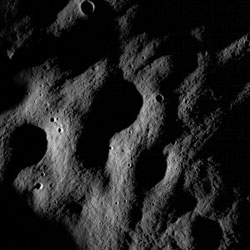First pictures of the moon

First pictures from mare nubium <br>NASA <br>
Yesterday (2 July 2009) the Lunar Reconnaissance Orbiter (LRO) – the American mission which left Cape Canaveral on 18 June 2009 with the aim of preparing a manned return to the moon – transmitted the first pictures back to Earth.
For Prof. Harald Hiesinger from the Institute of Planetology at Münster University this is a tremendous success. “I've never seen the moon like this before,” he says, “it's absolutely fantastic!” Hiesinger's is one of six experiments on board the LRO.
The new pictures were taken close to the so-called 'terminator', i.e. the dividing line between the dark and the light sides of the moon. The extremely low-lying sun emphasises the morphology of the surface through the long shadows cast. After six years of preparation Hiesinger is now delighted at these first pictures.
“The new high-resolution pictures show in unprecedented detail the moon's surface in the highlands south of the Mare Nubium, one of the dark volcanic surfaces on the south-west front side of the moon,” he says. On board there are several cameras, including one with a wide-angle lens and two equipped with tele-zooms. The high-resolution NAC camera maps the surface with around 50 centimetres per pixel, the WAC with around 100 metres per pixel.
“The hard work of the past few years is finally paying off,” says Hiesinger. “We can now see the smallest craters and the finest geological structures in these pictures, which we shall be evaluating in detail in the next few years. There'll be a lot to do – for students, too.” Hiesinger wants to let students work directly on the data. “For many of my students and staff this presents a unique opportunity to work directly on a mission that's underway. It means they're all highly motivated,” says Hiesinger, who was the only German to be selected by NASA right at the beginning of the mission.
Among other things, the team in Münster will be using the pictures to map the moon's surface precisely and determine its age. In doing so, the Münster scientists will be using a method which was already developed in the Apollo era and has been continually refined ever since. As a surface collects more and more craters, the longer it is exposed to bombardment by meteorites, the age of the surface can be determined by counting the craters. The first pictures released by NASA today do indeed show a large number of craters of varying sizes, which Hiesinger and his team will now immediately start counting.
“But we shall of course be looking very closely at the polar areas too.” he says, “These are especially interesting because it is suspected that there might be water in the deep craters in the polar regions.” As no ray of sunlight is likely to penetrate into these craters it is very cold there, so that water is able to freeze and remain stable for a long time there. “Water on the moon is of course an enormously valuable resource for all future astronauts. This water can be drunk or used as rocket fuel,” Hiesinger explains.
Another exciting question is the selection of safe landing spots for future manned missions. The Münster planetologists will be directly involved in looking for the best landing places. “Today's pictures are just the first appetizers,” says Hiesinger. “Over the coming year we will be getting many terabytes of first-class, spectacular pictures.” And as the Lunar Reconnaissance Orbiter used less fuel on its way to the moon than was planned, the mission will be able to orbit the moon for an estimated five years.
Media Contact
All latest news from the category: Physics and Astronomy
This area deals with the fundamental laws and building blocks of nature and how they interact, the properties and the behavior of matter, and research into space and time and their structures.
innovations-report provides in-depth reports and articles on subjects such as astrophysics, laser technologies, nuclear, quantum, particle and solid-state physics, nanotechnologies, planetary research and findings (Mars, Venus) and developments related to the Hubble Telescope.
Newest articles

Floating solar’s potential
… to support sustainable development by addressing climate, water, and energy goals holistically. A new study published this week in Nature Energy raises the potential for floating solar photovoltaics (FPV)…

Skyrmions move at record speeds
… a step towards the computing of the future. An international research team led by scientists from the CNRS1 has discovered that the magnetic nanobubbles2 known as skyrmions can be…

A flexible and efficient DC power converter for sustainable-energy microgrids
A new DC-DC power converter is superior to previous designs and paves the way for more efficient, reliable and sustainable energy storage and conversion solutions. The Kobe University development can…





















